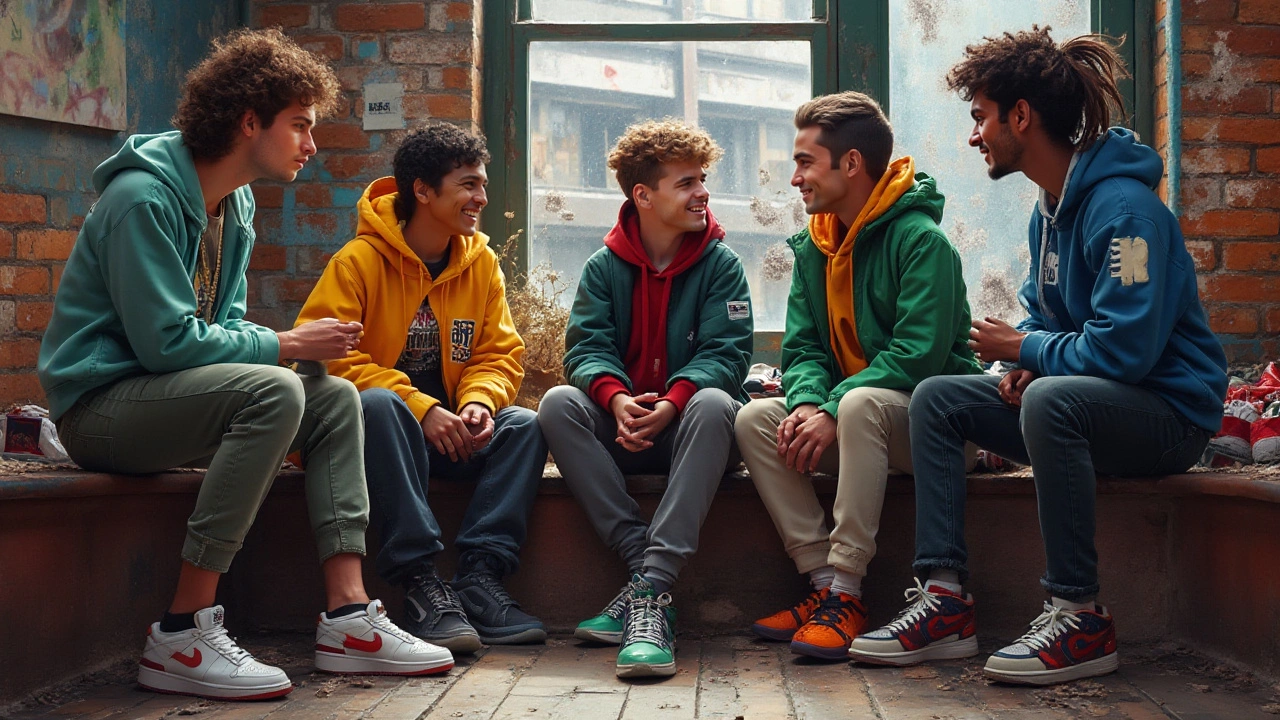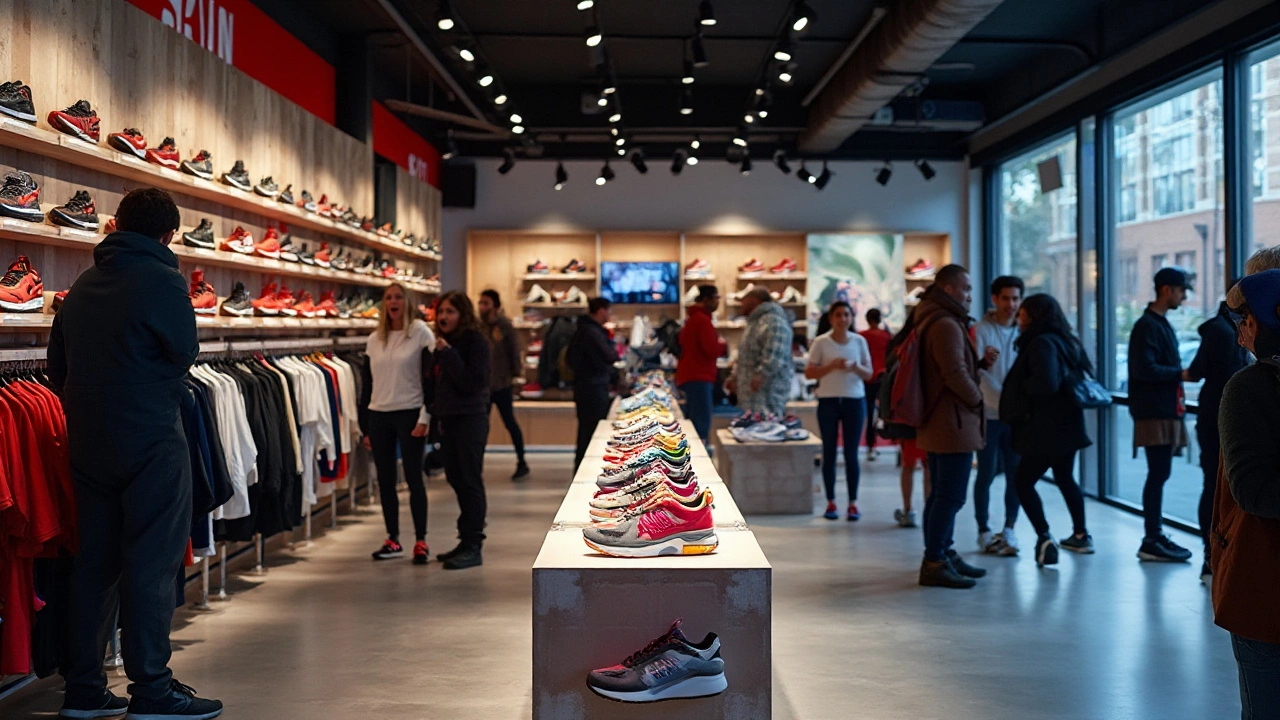The world of sports is not just about the action on the field; it's heavily influenced by the brands that design the gear athletes rely on. These brands have not only redefined how we play sports but also how we perceive them. A handful of companies have carved out their place at the forefront of the sports equipment industry, each with its distinct approach and legacy.
What sets these top brands apart is their commitment to combining cutting-edge technology with sleek design, ensuring athletes perform at their best while looking good. From creating trendsetting footwear to developing eco-friendly practices, their influence extends beyond performance to making a cultural impact.
- The Rise of Iconic Sports Brands
- Innovative Products and Technologies
- Cultural Impact and Sponsorships
- Future Trends and Sustainability Efforts
The Rise of Iconic Sports Brands
In the grand narrative of sports and athletic history, the rise of iconic sports brands is a tale of vision intertwined with tenacity. The journey of these brands began in modest surroundings, driven by individuals who had a burning passion and belief in the power of their creations. One such example is Nike, started by Bill Bowerman and Phil Knight in the early 1960s. Nike’s initial days were humble, with Bowerman often making shoes using a waffle iron to imprint the now-famous sole design. As of today, Nike stands tall with its swoosh being recognized in every corner of the world. Interestingly, the brand was inspired by the Greek goddess of victory, aptly reflecting its dominance in the realm of sports.
Over on the continent of Europe, Adi Dassler was quietly revolutionizing the world of athletic footwear in Germany. The eventual birth of Adidas created a brand known for both performance and style. Adidas' introduction of screw-in football studs during the 1954 World Cup is often credited with Germany's victory, setting a precedent for innovation in athletic footwear. Meanwhile, Puma, founded by Adi's brother, Rudolf Dassler, embarked on its journey focusing on sleek performance and cutting-edge design. Such sibling rivalry, in fact, fueled both companies to pursue excellence, shaping their paths as major players in the sports arena today.
As these brands began capturing athletic imaginations, an ecosystem of innovation started thriving. Reebok, another powerful player, took America by storm in the 1980s with its inventive high-tops, jazzed up with the 'Pump' technology. This was not just a shoe but a phenomenon, making it the go-to sneaker for everyone from aerobics enthusiasts to basketball lovers. Speaking about Reebok's essence aptly, Paul Fireman, an entrepreneur who gave Reebok its American wings, noted,
"Athletic shoes weren't just for performance; they became a statement of style."This shift set the stage for sports brands transitioning into lifestyle brands, redefining their roles in culture.
It's crucial to understand that these iconic sports brands didn’t just flourish overnight; there was continuous evolution, adaptability, and an understanding of customer dynamics that propelled them. A telling sign of their sustained growth is reflected in their market shares and brand valuations today. For instance, Nike leads with a staggering $34 billion valuation as of 2023, while Adidas follows with $14 billion, underlining the significance of branding in unlocking financial prowess. These figures freshly remind us of why these names not only symbolize performance but act as beacons inspiring generations.
Moreover, their rise is deeply etched in their ability to weave partnerships with athletes and influencers—they didn’t just endorse shoes; they sold dreams. When Michael Jordan leapt across screens, basketball courts, and urban landscapes, his Air Jordans weren’t just kicks; they signified aspiration, grace, and unparalleled ambition. In creating signature products like these, brands made an indelible impact and ensured their foothold in the annals of sports history. They've turned kids into fans and weekends into monumental sporting events, leaving an enduring legacy.

Innovative Products and Technologies
In the competitive arena of sports brands, innovation stands as the cornerstone of success, driving the industry's biggest names to continuously refine and revolutionize their offerings. At the heart of these advancements is the relentless pursuit of combining performance with comfort, which allows athletes to push their limits while reducing the risk of injury. One shining example of such innovative products comes from Nike, which has invested heavily in developing tech-based solutions for footwear, like their famous Flyknit technology. This groundbreaking method utilizes a lightweight, flexible material woven seamlessly for a perfect fit, enhancing both breathability and strength.
Another noteworthy trendsetter is Adidas, utilizing their Boost technology—a standout cushioning system that has redefined the concept of energy return. Created with thousands of tiny TPU granules that are steam-molded together, the result is an unparalleled cushioning effect that returns energy back to the wearer with each step, making it exceedingly popular amongst runners and casual wearers alike. The drive towards tech-infused project lines continues with Under Armour's smart shoes, which integrate sensors to collect biometric data, offering users real-time feedback and even coaching.
One of the most intriguing developments comes from Puma, famed for its continuous efforts to balance innovation with sustainability. Their "Forever Better" initiative underlines a clear commitment to eco-friendly products, as seen in Puma's biodegradable sneakers made from sustainable materials. These initiatives not only address modern demands but also set an example for the rest of the industry. As the landscape of sports gear undergoes this tech-driven transformation, brands are keenly aware of customer focus shifts—desiring both high performance and environmental responsibility.
SportTechie magazine aptly states, "Brands redefining athletic standards fill critical gaps, addressing athletes’ broader needs and tailoring products for peak performance." This sentiment captures the essence of what makes these top brands successful. They are storytellers, athletes' companions, and innovators breaking down barriers between challenge and triumph.
The journey of creating these products often involves thorough research and development phases where prototypes are subjected to rigorous testing before reaching consumers. The objective remains consistent—strike a balance between high performance, aesthetics, and cutting-edge technology. The incessant drive towards better functionalities can also be attributed to the strategic collaborations between brands and athletes contributing unique insights from firsthand experiences.
This narrative of innovation is not limited solely to product design but extends into marketing and customer engagement strategies. Brands regularly host events showcasing new releases and technological advancements, creating fascinating experiences for sports enthusiasts. Whether embracing virtual reality to simulate product features or employing augmented reality for personalized fit consultations, these companies ensure an engaging experience while iterating design excellence.

Cultural Impact and Sponsorships
When it comes to sports brands, their influence extends far beyond the fabric of activewear and the design of athletic shoes. Through sponsorships and impactful marketing strategies, these brands have entered the cultural zeitgeist, creating a significant ripple effect on both sports and society. Sponsorship is often the linchpin in this dynamic, allowing consumers to form a palpable connection with their favorite athletes who don their gear. When a basketball legend like Michael Jordan partnered with Nike, it wasn’t just a commercial transaction; it catapulted Nike’s Air Jordan into an icon, blending sports and streetwear fashion. Such collaborations have enabled brands to transcend the realm of mere athletic gear providers, embedding themselves into the broader cultural tapestry.
Brand sponsorships have long had a profound effect on sports communities and events around the world. From local league teams to international championships, companies like Adidas, Puma, and Under Armour pour resources into nurturing talents and dreams. By supporting aspiring athletes with free equipment or financial aid for training, these firms not only bolster player development but enhance brand loyalty, cultivating a lifetime of enthusiastic endorsement. Moreover, brands use creative advertisements and aspirational storytelling to inspire and engage a global audience. Each year, the Super Bowl highlights how adeptly sporting companies wield their advertising genius—oftentimes overshadowing the game itself due to the creativity of their ads. Sponsorship, advertising, and fashion have merged into an amalgam that epitomizes sports culture in the modern era.
Athletic gear has also become a mode of expression for people who may have never set foot on a playing field. With fashion fusing with functionality, sports brands have spearheaded athleisure, a trend that took root in the 21st century but is now entrenched in daily wardrobes. The integration of athletic aesthetics into mainstream fashion has ignited fresh debates about identity and authenticity in sports. "We want to bridge the gap between performance and style," says Sarah Newkirk, Adidas's Global Brand Strategy Lead, "because we believe being active is for everyone." Such narratives not only promote inclusivity but also solidify sporting brands as torchbearers of a significant cultural movement. They influence consumer behavior, lifestyle choices, and ultimately reflect a society driven by activity and personal betterment.
Engagement does not end at sponsorships; it evolves into crafting experiences. Various sports companies host pop-up events, run marathons, and even launch grand expos, where athletes and fans can converge to celebrate sport and community. These interactions foster a sense of belonging and kinship, turning passion into a lifestyle. In an age where experiences often outstrip material possessions in importance, these events are more significant than one might assume, providing a tactile touchpoint to a brand's ethos. For every successful company, the strategy is to morph their public representations into inspirations, convincing audiences that they’re not just consumers, but actively part of a movement, a lifestyle choice that resonates on a cultural level.
Given the cultural potency of sports equipment brands, it becomes apparent how they've crafted narratives that are not merely product-centric but deeply relatable. Their marketing is carefully orchestrated to align with prevailing social themes, from sustainability to social justice, often magnifying their influence through partnerships with notable figures. This strategic alignment allows these brands to narrate a compelling story that appeals to the deeper aspirations and conscientiousness of the consumer. By responding to socio-political landscapes and consumer demands, sports brands have successfully anchored themselves not just in the world of sports but in the very fabric of global culture.

Future Trends and Sustainability Efforts
As we move forward, the sports industry confronts challenges that call for innovation and responsibility. A growing trend is the push towards sustainability in sports equipment manufacturing, set by pioneers like Adidas and Nike. These companies are not only famous for their performance-enhancing gear but also for their eco-conscious strategies. More brands are now turning to sustainable materials like recycled polyester and organic cotton to craft their athletic gear, thereby reducing their carbon footprint. For instance, Adidas’s Parley initiative transforms plastic waste from oceans into fashionable, functional apparel and footwear, showcasing that sustainability can indeed pair seamlessly with style and performance.
In the realm of technology, the integration of smart fabrics and wearable tech is changing how athletes train and recover. This includes clothing that monitors physical activity and provides real-time data analysis, helping individuals adjust their training regimens for optimal performance. Such innovations not only enhance athletic performance but address health and safety concerns, a critical aspect in professional and amateur sports alike.
"Innovation is leading us to a future where technology becomes an essential part of every athlete’s journey. The challenge lies in making these advancements sustainable," says Jon Smith, a notable sports technology analyst.
The digital evolution has also paved the way for more interactive customer experiences. Virtual reality (VR) and augmented reality (AR) are being used to create immersive marketing strategies that engage customers like never before. Brand loyalty is fostered not just through product quality, but through creating communities and experiences that resonate with their audience. Virtual fitting rooms and AI-driven shopping assistants are just the beginning of what’s to come in the next era of retail experience.
Sustainability isn’t only about what’s new today; it’s about reshaping the future. Companies recognize the need for sustainable practices not just in manufacturing but also in their corporate policies. Sustainable packaging, waste reduction efforts, and transparent supply chains are becoming standard expectations. The engagement doesn’t stop there; they continuously work hand-in-hand with environmental organizations to ensure that recreational activities can persist without harming the planet.
Talking about the future, it is crucial to acknowledge the part that consumers play. The demand for sustainable activewear rises, driving brands to rethink their production processes. Customers today are well-informed and prioritize planet-friendly choices, holding corporations to higher standards than ever before. It's a cycle of awareness, expectation, and gradual implementation where everyone plays a role.
As the world of sports continues to evolve, the amalgamation of sustainability with technology isn’t just a trend; it’s a tangible step towards a greener, more efficient sports landscape. The industry's ability to adapt and thrive hinges on how well it can balance innovations with the ecological demands of the modern world. For athletes and consumers alike, the future is now in their hands—or rather, in their shoes, shirts, and gear crafted for the planet and for performance.
